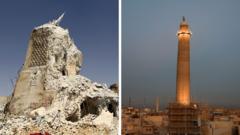In a remarkable comeback, Mosul’s historic landmarks are reopening after the chaos brought on by the Islamic State group in 2014. UNESCO, in collaboration with local communities and international funding, began the restoration project after the city was liberated in 2017. This week, a ceremony celebrating the reopening of key landmarks, attended by UNESCO’s director-general and Iraq's Prime Minister, marked a significant milestone in Mosul's revival.
Once a symbol of co-existence among diverse communities, Mosul was devastated during IS's brutal rule, which lasted three years. Amidst the rubble, famous sites such as the leaning al-Hadba minaret and several sacred churches and mosques suffered serious destruction. Local photographer Ali al-Baroodi described the scenes after the battle: a ghost town marked by tragic loss and destruction.
With a budget of $115 million, generously provided by donors including the UAE and the European Union, the extensive effort aims not just to reconstruct buildings but to rebuild the spirit of the community. The project led to the restoration of 124 houses and other significant sites, like the Dominican convent and Al-Tahera Church, which allowed people to return to their ancestral homes.
Father Olivier Poquillon, overseeing the convent’s restoration, highlighted the importance of fostering trust among different religious groups for the work to be successful. Over 1,300 youths gained traditional skills during the initiative, creating 6,000 new jobs and showcasing unity among ethnic and religious denominations.
With landmarks like the reconsecrated al-Hadba minaret and Al-Nuri mosque now part of the skyline again, hope and healing permeate the streets of Mosul. Residents like Mustafa and Abdullah express deep gratitude at returning to their restored homes, lighting the way for the future of this historically rich city, as its residents strive to revive the culture and identity intertwined in its walls. Each restoration stands as a testament to resilience, and as al-Baroodi beautifully puts it, it feels like watching a once lifeless city come vibrantly back to life.





















